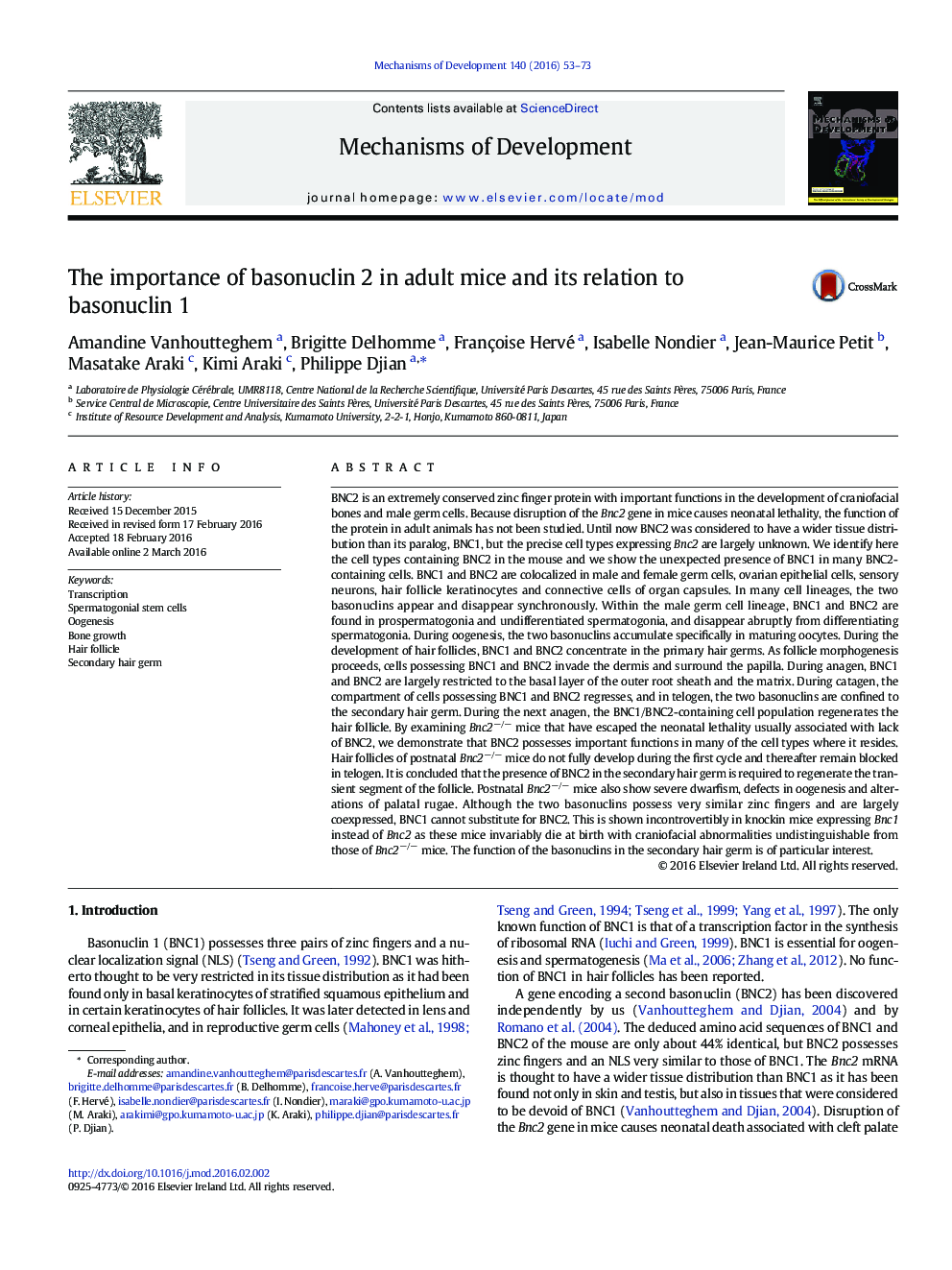| کد مقاله | کد نشریه | سال انتشار | مقاله انگلیسی | نسخه تمام متن |
|---|---|---|---|---|
| 2194532 | 1550569 | 2016 | 21 صفحه PDF | دانلود رایگان |
• We study the expression of paralogous zinc finger proteins BNC1 and BNC2 in mice.
• We examine the phenotype of adult Bnc2-null mice.
• Bnc1 and Bnc2 have nearly identical expression patterns.
• In hair follicles BNC2 is specific to germ cells and is required for cycling.
• BNC1 cannot compensate for lack of BNC2.
BNC2 is an extremely conserved zinc finger protein with important functions in the development of craniofacial bones and male germ cells. Because disruption of the Bnc2 gene in mice causes neonatal lethality, the function of the protein in adult animals has not been studied. Until now BNC2 was considered to have a wider tissue distribution than its paralog, BNC1, but the precise cell types expressing Bnc2 are largely unknown. We identify here the cell types containing BNC2 in the mouse and we show the unexpected presence of BNC1 in many BNC2-containing cells. BNC1 and BNC2 are colocalized in male and female germ cells, ovarian epithelial cells, sensory neurons, hair follicle keratinocytes and connective cells of organ capsules. In many cell lineages, the two basonuclins appear and disappear synchronously. Within the male germ cell lineage, BNC1 and BNC2 are found in prospermatogonia and undifferentiated spermatogonia, and disappear abruptly from differentiating spermatogonia. During oogenesis, the two basonuclins accumulate specifically in maturing oocytes. During the development of hair follicles, BNC1 and BNC2 concentrate in the primary hair germs. As follicle morphogenesis proceeds, cells possessing BNC1 and BNC2 invade the dermis and surround the papilla. During anagen, BNC1 and BNC2 are largely restricted to the basal layer of the outer root sheath and the matrix. During catagen, the compartment of cells possessing BNC1 and BNC2 regresses, and in telogen, the two basonuclins are confined to the secondary hair germ. During the next anagen, the BNC1/BNC2-containing cell population regenerates the hair follicle. By examining Bnc2−/− mice that have escaped the neonatal lethality usually associated with lack of BNC2, we demonstrate that BNC2 possesses important functions in many of the cell types where it resides. Hair follicles of postnatal Bnc2−/− mice do not fully develop during the first cycle and thereafter remain blocked in telogen. It is concluded that the presence of BNC2 in the secondary hair germ is required to regenerate the transient segment of the follicle. Postnatal Bnc2−/− mice also show severe dwarfism, defects in oogenesis and alterations of palatal rugae. Although the two basonuclins possess very similar zinc fingers and are largely coexpressed, BNC1 cannot substitute for BNC2. This is shown incontrovertibly in knockin mice expressing Bnc1 instead of Bnc2 as these mice invariably die at birth with craniofacial abnormalities undistinguishable from those of Bnc2−/− mice. The function of the basonuclins in the secondary hair germ is of particular interest.
Journal: Mechanisms of Development - Volume 140, May 2016, Pages 53–73
